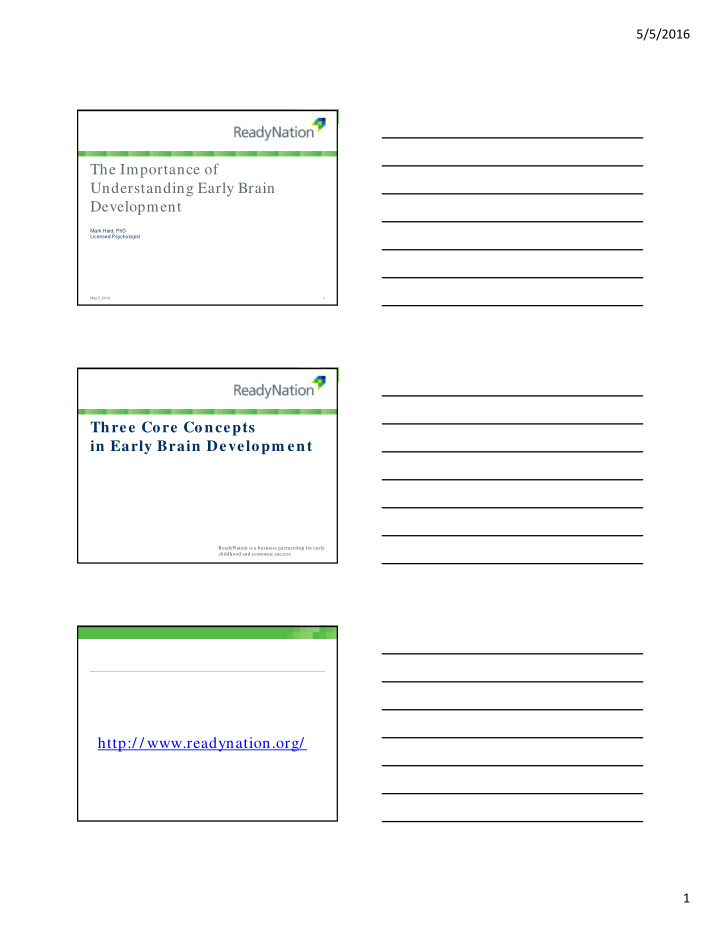



5/5/2016 The Importance of Understanding Early Brain Development Mark Hald, PhD Licensed Psychologist May 5, 2016 1 Three Core Concepts in Early Brain Developm ent ReadyNation is a business partnership for early childhood and economic success http:/ / www.readynation.org/ 1
5/5/2016 5/5/2016 4 “We are hardwired for relationships” Allan Schore Brains develop and organize in the context of relationships. Positively and Negatively , 2
5/5/2016 The Foundation of a Successful Society is Built in Early Childhood Successful Parenting of Next Generation Educational Econom ic Responsible Lifelong Achievem ent Productivity Citizenship Health 7 Three Core Concepts of Developm ent 1 Brain Architecture Is Established Early in Life and Supports Lifelong Learning, Behavior, and Health 2 Stable, Caring Relationships and “Serve and Return” Interaction Shape Brain Architecture 3 Toxic Stress in the Early Years of Life Can Derail Healthy Development 8 Brain Architecture Supports Lifelong Learning, Behavior, and Health • Early experiences shape brain architecture. • Simple skills come first; more complex skills build on top of them. • A strong foundation in the early years improves the odds for positive outcomes and a weak foundation increases the odds of problems later in life. 9 3
5/5/2016 Shifting Developm ental Activity across Brain Regions (Perry) Brain Region Age of Key functions Age of greatest developmental functional activity maturity Neocortex Childhood Adult Reasoning, problems solving, abstraction, secondary sensory integration Memory, emotional regulation, Limbic Early Puberty attachment, affect regulation, Childhood primary sensory integration Motor Control, secondary Diencephalon Infancy Childhood sensory processing Brainstem In utero Infancy Core physiological state regulation, primary sensory processing. Neural_tube_fold.wmv • Neural_tube_fold.wmv • fetal brain develpment.wmv 4
5/5/2016 The Neuron Experiences Shape Brain Architecture 70 0 neural connections per second in the early years 6 years 14 years Birth Image source: Conel, JL. 14 Brain development windows – Fetal period until two to three years plus. – Blueprint that influences every system in the body. – Immunity – Expression and regulation of emotion, Nervous system resilience – Attachment 5
5/5/2016 Brain development windows – Communication – Intelligence – Self-regulatory mechanisms for such basics as body temperature and hormone production. (State Regulation) – States become traits Perry… Overview of Psychosocial Development • Need for “Secure” attachment relationships in early childhood • Social emotional development = mental health (3 r’s) – Experience, regulate & express emotions – Explore environment & learn • Early social interactions impact future relationships 6
5/5/2016 Imitation starts at birth • Mirror neurons • Ten-minute old newborn doing tongue-protrusion and mouth-opening, ala Meltzoff experiments. • Neonate_imitation.wmv • “Micro events” Serve & Return Builds Brains and Skills • Ongoing, reliable interaction with trusted adults is essential for the development of healthy brain circuits. • Systems that support the quality of relationships in early care settings, communities, and homes help build brain architecture. 20 Developmental Sequences Physical and Social Emotional Language Feedings: 5 ‐ 8 per day Generalized Tension Helpless Asocial Sleep: 20 hrs per day Fed by mother Birth Sensory Capacities: to makes basic 1 month distinctions in vision, hearing, smelling, tasting, touch, temperature, and perception of pain 7
5/5/2016 Developmental Sequences Physical and Social Emotional Language Sensory Delight Visually fixates at a Capacities: color face, smiles at a face, perception, visual Distress may be soothed by exploration, oral rocking. exploration. Smiles at a Face 2 months to Sounds: cries, coos, 3 months grunts Motor Ability: control of eye muscles, lifts head when on stomach. Developmental Sequences Physical and Language Emotional Social Sensory Enjoys being Recognizes his Capacities: localizes cuddled mother. Distinguishes sounds between familiar Sounds: babbling, makes persons and strangers, 4 months most vowels and about no longer smiles to half of the consonants indiscriminately. 6 months Feedings: 3 ‐ 5 per day Motor ability: control of Expects feeding, head and arm dressing, and bathing. movements, purposive grasping, rolls over. Developmental Sequences: Critical period for attachment Physical and Social Emotional Language Motor Specific emotional Enjoys "peek ‐ a ‐ boo“ Ability: control of attachment to mother. trunk and hands, Emergence of sits without Protests separation from “I love you rituals.” support, crawls mother. about. 6 months Begins to connect to sensations such as 8/9 months discomfort or hunger and his/her own actions to regulate those feelings such as crying, fussing directed at caregiver 8
5/5/2016 Quality Early Care and Education Pays Off: Cost/ Benefit Analyses Show Positive Returns $10 $9.20 $8 $5.70 Total Return per $6 $1 Invested $3.23 $4 $2 Break-Even Point 0 Nurse Family Perry Preschool Abecedarian Project Partnership (early education age 3-4) (early care and (home visiting education aged 0-5) prenatal – age 2 for high risk group) Heckman et al. (2009) Data Sources: Karoly et al. (2005) Graph Courtesy: Center on the Developing Child at Harvard University 25 Keys to Healthy Developm ent A balanced approach to emotional, social, cognitive, and language development, starting in the earliest years of life. Supportive relationships and positive learning experiences that begin with parents but are strengthened by others outside the home. Highly specialized interventions as early as possible for children and families experiencing significant adversity. For m ore on business cha m p ions: For m ore on the science: w w w .d ev elop ingchild .ha rv a rd .ed u w w w .Rea d y Na tion.org 26 9
Recommend
More recommend